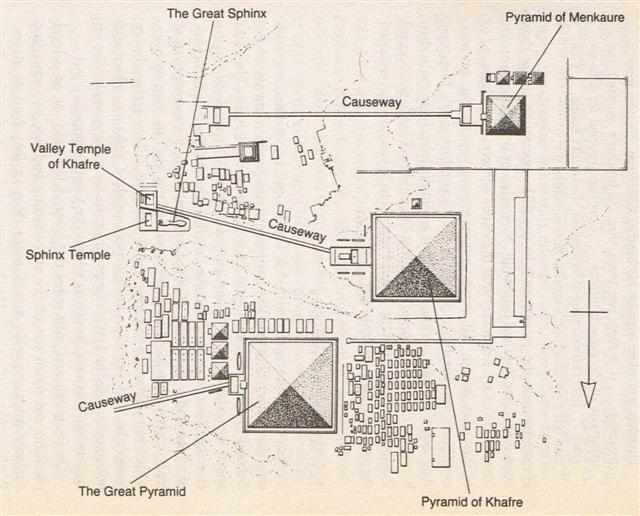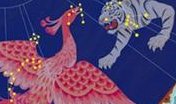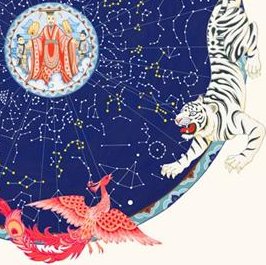The toga signs do not end with Adara, there are 2 more. But as the last glyph in the line is 2-22 we will postpone a discussion of these until they appear in line Ka3. Instead, let's once again contemplate the Chinese structure:
The eye of the Red Bird seems to be ι Gemini, which we so far has not listed.
The ruling star of the Chinese 22nd station coincides with 'June 24, on the brink of the new year after the solstice, in K evidently coordinated with the 1st Rei (of only 5 in the text):
Clearly Castor is on the other side of the Milky Way compared to Orion and somehow Sun apparently manages to cross the gap between White Tiger and Red Bird. But it may be just in our imagination, fooled by his mirror apparition formed from the smoke rising from his ashes (rehu).
John needed water to baptize Christ. He could correspond to Castor (with his left foot in the Milky Way River). However, the Chinese name Well connected with Gemini should rather refer to their circular asterism centered on Sirius, which seems to be the last station for Old Sun - after having moved farther and farther south yet finding no bridge to cross over:  The gap between White Tiger and Red Bird is wide and in between it is easy to perceive what well could be a well, above the outstretched right front paw (Mebsuta, ε Gemini) of the white-haired Old Tiger: ... Mebsuta is from Al Mabsutāt, the Outstretched, from its marking the extended paw of the early Arabic Lion, but now it is on the hem of Castor's tunic ...
Thus I think the Well figure refers not directly to Gemini but to a place far down below (muliphein). The asterism has a central star surrounded by 13 others and the figure is hardly to be found by observing the night sky. Instead it is a creation of the human mind. This Well is drawn as rising close to the Tejat 'door'. The obvious candidate for its central star is Sirius (close to Mebsuta) and the surronding 13 'feathers' will then represent the 13 months in the cycle of a year. The brightest star in the picture above is even farther down, drawn below the beak of the Red Bird. Between this great star and the Sirius 'well' there is a configuration which could correspond to Argo Navis. When anciently the Emperor of China had a duty to draw his Bow towards Sirius he used no arrow:
This Sirius Jackal evidently stands in a kind of pool. I guess the great ball behind him refers to Canopus. The Arrow is not there because Tautoru signifies a dark time close before the solstice, when of course not only Sun but also the Sun Emperor will be threatened by death, might be hurt by the sharp point (tara) of an arrow.
These 3 glyphs at the very beginning of the text could be meant to tie together the old cycle with the new one, beginning on the other side of the Milky Way (the river for transmigration of souls). Nga Kope Ririva Tutuu Vai belonged not to Hau Maka (as the rest of Easter Island) but to Te Taanga. ... the creator of the text may have thought the 2nd and 3rd stars in the Belt of Orion, Alnilam and Alnitak, already were represented, so to say, at the beginning of the text ...
The 3 great pyramids at the burial ground of Gizah are on the west bank of the Nile and they are designed to correspond to the Belt Stars of Orion:  ... Bauval realized that an areal viw of the Giza necropolis would show the Great Pyramid of Khufu occupying the position of Al Nitak, and the Second Pyramid of Khafre occupying the position of Al Nilam, while the Third Pyramid of Menkaure was offset to the east of the diagonal formed by the other two - thus completing what seemed at first to be a vast diagram of the stars ... We should now incorporate ι Gemini in our data base:
The 'little' (iota) eye of the Red Bird, Propus, was rising heliacally in 'July 10 and we can imagine 7-10 as a Sign for 710 = 2 * 355 or just around the 'corner' located at twice 12 * 29½. Gemini means twins. | ||||||||||||||||||||||||||||||||||||||||||||||||||||||||||||||||||||||||||||||||||||||||||||||||||||||||||||||||||||||||||||||||||||||||||||||||||||||||||||||||||||||||||||||||||||||||||||||||||||||||||||||||



.jpg)








